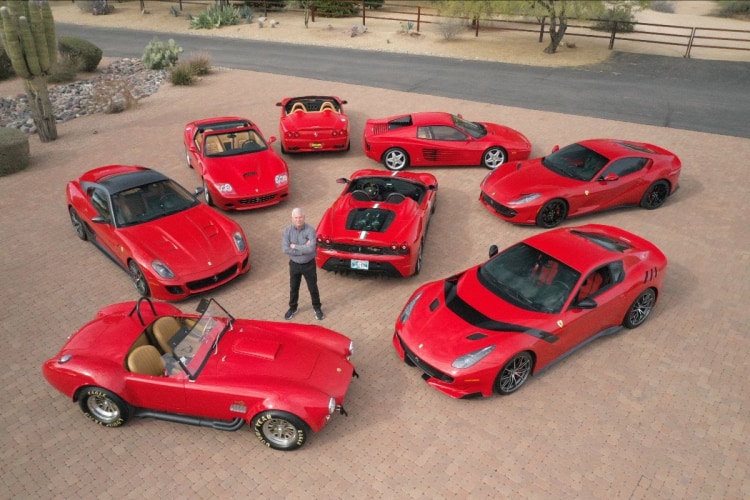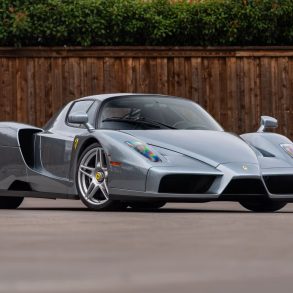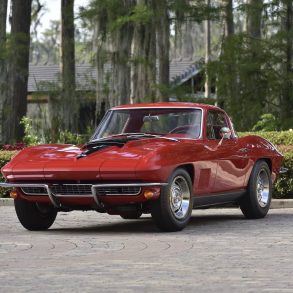March 18-20 will see Mecum Auctions hosting its third annual auction at the State Farm Stadium in Glendale, Arizona. The 2021 Mecum Glendale auction will have an anticipated 1,200-car lineup with the highlight of the event being Steve Todhunter’s magnificent collection of 20 vehicles.
Feature vehicles of the collection include seven low-mileage, exquisite Ferraris, a 2014 Mercedes-Benz SLS AMG Black Series, and a 1965 Shelby 427 Cobra FAM that was previously part of the late actor, Paul Walker’s collection.
Todhunter is not just a conventional car collector, he has an eye for evolution. His collection includes the horsepower heavyweights from the golden era of muscle cars, the rarest Mopar machine examples, and Ferraris. Todhunter’s choice for strong and powerful machines has followed a path of development centered on quality over quantity. Instead of accumulating cars to grow his collection in terms of number, Todhunter continuously raised the bar of his collector cars in terms of rarity and desirability.
In addition to the Steve Todhunter collection, another highlight of the auction is the Napa Valley Collection, which will feature a 1973 Porsche 911 Carrera RS 2.7, being one of only 1580 produced, and a 1966 Chevrolet Yenko Stinger Stage II.
Here’s a look at a few featured cars on offer at the 2021 Mecum Glendale auction.
1965 Shelby 427 Cobra FAM
Estimate: $275,000 – $325,000
A genuine Shelby Cobra is already an extremely rare automobile, but this CSX1000 series 427 sets the bar higher as this example is one of only two that were made out of a planned production of only 10 “FAM” edition.
The example was personally commissioned by Carroll Shelby and was one of the 14-car group that AC Motor Holdings (formerly AC Cars) produced, the designation of the example well known to any Shelby history buff.

The example was previously in the possession of the late actor Paul Walker from “Fast and Furious.” It sports a hand-rolled aluminum body made by AC craftsmen and proudly displays special “FAM 427 Special Edition” badges instead of the usual “Cobra” and “Shelby 427 SC” emblems.
The CSX1010 has a matching-numbers Shelby 427 FE aluminum V8 engine with a Tremec TKO600 5-speed manual transmission. It is equipped to SC specification, complete with all-independent coil-spring suspension, rack-and-pinion steering, remote engine oil cooler, Wilwood brakes with Shelby calipers, a high-capacity aluminum radiator that is cooled by dual “pusher” electric fans, and a Shelby differential cover.

The example also has a black-painted roll bar with matching side exhaust, “Tripod” headlights, black-painted quick jacks, and Goodyear Eagle tires on the Halibrand-style 15-inch 6-spoke pin drive wheels.
The SC theme can also be seen within the custom cockpit with specifications’ dash layout and Carroll Shelby Signature gauges arranged along with Lucas-style control knobs and toggle switches. Also within the interior is a Ford T-bar shifter, a 15-inch original style wood-rimmed steering wheel, heavy-duty competition lap belts, and custom Shelby carpeting.

Being one of only two Shelby Cobra 427 FAM editions made, the CSX1000 is a great piece of Cobra history.
2014 Mercedes-Benz SLS AMG Black Series
Estimate: $450,000 – $500,000
Only 132 units of the Mercedes-Benz SLS AMG Black Series were ever produced, and out of the 132, only five units were given the Fire Opal Red finish. The example is one of the five, making it one of the most exclusive cars to sport the three-pointed star.
After Mercedes-AMG developed the first SLS GT from the ground up, it became an instant classic due to its flashy gullwing design and performance deserving of the original 300SL that inspired it.


The example being offered has traveled just 2,326 miles. It comes equipped with a lightweight polished AMG forged aluminum wheels with Michelin Pilot Sport Cup 2 tires and large carbon-ceramic disc brakes.
The interior is trimmed in black Alcantara leather with red accents and the cockpit is designed to focus on the driving experience. It contains the AMG Performance steering wheel, tailored controls, and snug-fitting heated bucket seats.

2016 Ferrari F12tdf
Estimate: $900,000 – $1,000,000
Only 799 Ferrari F12tdf were produced worldwide, with this specific example originally owned by Roger Penske, Indianapolis Motor Speedway, and Team Penske owner.
The example is presented in a gorgeous Rosso Corsa finish matched with a red and black interior. Behind the 20-inch alloys with Pirelli P-Zero tires are red-painted brake calipers completing the whole look.


The former Penske-owned example has even improved on the already impressive performance with the additional options amounting to almost $55,000. The standard engine filter box cover was replaced with carbon fiber, as well as the under-door covers, exterior trim, vents, rear diffuser, intakes, headlight, and fog lamp enclosures.
The seats are covered in Alcantara, as well as the headliner and the boot. The rear shelf and bench trim are also finished in carbon fiber.

1966 Chevrolet Yenko Stinger Stage II
Estimate: $70,000 – $90,000
The supertuned Camaros, Novas, and Chevelles by Don Yenko are all popular, but not many people would know that without the 100 Corvair-based stingers that Yenko and his crew built in December 1965 for SCCA racing, all those other cars would not exist.

The example, with Yenko Serial No. YS-050 was sold new at Yenko Chevrolet, and it is the 50th of those first 100. The Stinger has been given a complete and thorough mechanical and cosmetic restoration to return it to its original condition when it rolled out of Yenko’s Shop in Canonsburg, Pennsylvania, around 55 years ago.
Yenko’s frustration on the racetrack is what created the Stinger. Yenko was a championship-winner Corvette racer, and by 1965 he claimed:
“I got tired of looking at the rear bumper of Mark Donohue’s Mustang. The only way I could stay loyal to Chevrolet was to build my own car.”

The example has only had two owners from new. It is equipped with the Stage II engine that is able to generate 190 HP. This is made possible thanks to its high-performance camshaft, heavy-duty valve springs, 10:1 compression heads, exhaust headers, and four carburetors.
In 1966, to make it eligible for D/Production racing, SCCA required 100 Stingers to be produced. Yenko’s team was able to accomplish the herculean task in just a month. A little more than two dozen more units were made, making it the rarest of the Yenko built machines.

Porsche 911 Carrera RS 2.7
Estimate: $400,000 – $500,000
One of 1,580 Porsche 911 Carrera RS 2.7 produced, this example is the embodiment of the changes in Porsche’s approach to racing after the incredibly successful 917 program, which had been limited to the North American Can-Am series after the FIA for international competition outlawed it.

By then, the 911 had already cemented its reputation as a sports and rally competition winner, being hailed as the ideal dual-purpose sports car. Through the 1960s, Porsche had increasingly placed their racing reputation on a series of prototypes whose aim was to compete for the various International Championships of the FIA. It was a campaign that resulted in the powerful 917 in Sports Prototype and Can-Am configuration.
In March 1972, Rico Steinemann stepped down as head of Porsche and Ernst Fuhrmann took over. During this time, the sales for 911 were declining. Fuhrmann however had a two-pronged plan to reverse the trend: he dramatically reduced the astronomical costs they were incurring with the turbocharged Can-Am 917, and construct future racing credentials using the car that was universally and easily identifiable as a Porsche – the 911.
Fuhrmann described the program as:
“an interesting adventure. Now we are going to stay closer to production cars.”
They already had all that they needed to create a winning Porsche 911 GT racer, all that was required would be to incorporate into a production 911 all the elements needed to homologate it for FIA Group 4 competition. Fuhrmann gave the task to 33-year-old engineer Norbert Singer as he had previously played a pivotal role in the development of the 917, making it one of the greatest race cars in history.

The first thing that Singer did was to reduce the weight of the 911 to target Group 4 regulations. The standard sheet steel body panels used (1.0 and 1.25mm thickness) were replaced with .7 or .8mm stock.
The interior was another great place for reducing weight. The factory carpet and sound insulation were replaced by rubber sheeting, the rear seat was removed, while thinly padded Recaro racing bucket seats with simple manual adjusters replaced the front seats.
After reducing all the unnecessary weight, Singer’s attention shifted to the car’s handling. For the first time on a production Porsche, lightweight Bilstein gas-pressurized shock absorbers were used.
The most important part of the Carrera RS is the larger 2.7-liter flat-6 engine with a displacement of which permitted it to be increased under FIA rules to the next class size of 3.0L

Almost 50 years after it was first introduced, the Carrera RS 2.7 is still one of the most sought-after Porsches made, both in their lightweight and touring variants. It was the car that catapulted the Porsche 911 platform to dominate the world of motorsport.
The example has been documented since new with only five owners, and it has been under the care of its current owner for 20 years.
Further information regarding the vehicles of the 2021 Mecum Glendale Auction can be found on Mecum’s website.
[Source: Mecum Auctions. All photos courtesy of Mecum Auctions, Inc]










